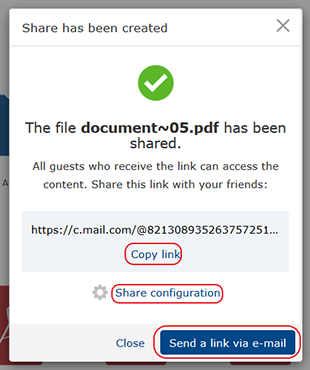How to send a large file by email: Attachments & file-sharing functions
Are you looking for a safe way to transfer a large file by email but not sure of the best way to go about it? We get it – attachment size limits vary from provider to provider, and it can be tricky to know what to do when you get the dreaded “Attachment exceeds the allowable limit” error message. Luckily, you have options!
Today we explain the three best ways to share large files – for free!
by Alyssa Schmitt

What is the best way to share a large file?
Depending on how large the file actually is, consider one of these three options:
- Send the file as a regular email attachment
- Compress the file by saving it in a zip format or folder
- Use an online file-sharing service to transfer the file
Let’s take a deep dive into each of these options!
Send a large email attachment
Attachments take up space on mail servers, and too many large files whizzing back and forth can overload networks and slow down service for all users. With this in mind, most email providers limit the size of the files – documents, photos, videos, etc. – that you can send as an email attachment. This limit may apply not only to the sender’s email but also to the recipient’s email provider policy. So, even if your email provider lets you send attachments up to 50 MB, if the recipient has a 25 MB limit, your email may still bounce back.However, sending a file as a regular email attachment is still extremely fast and convenient, so if your large attachment is within the limits of the email provider in question, this is probably your most practical option.
What is the maximum size limit for sending large files?
Here are the attachment limits of some popular email providers (in 2024):- Outlook: 20 MB
- Zoho Mail: 20 MB (personal user)
- Gmail: 25 MB
- Yahoo: 25 MB
- Proton Mail: 25 MB
- mail.com: 30 MB (free version)
- GMX.com: 50 MB
How many attachments can you send in an email?
You can send as many attachments as you like with one message – until the size limit is reached. In other words, the attachment limit is measured in terms of the total size of the attachments to a single email. So, if you want to send two 15 MB files and your email provider has a 20 MB attachment size limit, you’ll have to attach them to separate messages – or consider the options below.Good to know: Sending large file attachments with mail.com
For large file emailing, mail.com sets an attachment size limit of 30 MB for our free email accounts – larger than almost any other free email service – and a whopping 100 MB for our Premium customers. If your attachment size falls within these limits, you can simply attach it as usual in your Compose E-mail window by clicking the paperclip symbol on the top bar or in the lower left corner and then selecting the file(s) from your computer hard drive or the mail.com Cloud.
Compress email attachments to make them smaller
If you want to email a large file (or lots of small files that add up to more than your attachment limit), there is a way to make it smaller. This is called “compressing” the file, although it’s also referred to as “zipping” because of the name of the most common tool used for this process. Compressing a file or large email attachment can make it roughly 50 to 90 percent smaller, depending on the file type.Several files can also be placed together in a single compressed folder. It is very easy to compress a file, and the process is similar on most computers: You simply right-click your file(s) and select the relevant command, which will be something along the lines of Compress, Zip, or Send to Zip folder. This will create a new file of the same name with a .zip extension, which you can now attach to your email exactly as described above.
Need more help with this? Check out our blog post for easy-to follow instructions: How to compress a file to ZIP: Step by step.
Send a large file by sharing an online link
Attaching your file to an email may not always be the right option: even after compression it may exceed your limit, or your recipient may have a more restrictive email limit or data plan that makes it hard for them to receive big attachments. In this case, a secure online file-sharing service is your best option to send large files. One safe and easy way to do this is through link sharing. This function is often integrated into your email service (if it also offers cloud storage), making it simple to send large files for free.What is link sharing?
If your file is too large to send as an attachment, many cloud storage services let you share it with your recipient(s) using what is known as a “share link.” You upload your file to the cloud, and the program generates a URL link to the file’s location. You can then send the link to others using email, a text message, etc.When a recipient receives a share link, they just have to click it to access the stored file. It will usually open in a preview window on their device. In most cases, they will also have the option to download or print the file, although some file-sharing services may allow you to send a file as a restricted, “read-only” version instead. Share links are a secure way to send files: the recipient cannot access other files in your cloud, and, if you prefer, most service providers will let you password-protect the link or limit who can view it.
If you often need to send large files by email, we suggest you choose an email provider that offers integrated cloud storage with a link-sharing option, such as mail.com (mail.com Cloud), Gmail (Google Drive), Proton Mail (Proton Drive), etc. Link sharing is also offered by some cloud service providers such as Dropbox. However, when your cloud storage is integrated into your email, you can seamlessly share photos, project files, large MP3 files, etc. for free, simply by creating and emailing a share link.
File-sharing FAQs
You may have questions about sharing files via links:
How do I send large files like videos and images?
File-sharing links can be used to send pictures as well as audio (e.g., MP3) and video (e.g., MP4) formats. The same process applies regardless of file format: upload the file you want to send to your cloud service and create a share link to send to your recipient. For more information, see Unlocking the power of Cloud photo storage: benefits, security & tips
How long will it take to upload a large file?
When you want to send a file using link sharing, the first step is to upload the file to your cloud service. The upload speed will depend on the speed of your internet connection – if you are not sure how to test it, see our deep dive: How to do an internet speed test. If you know your internet speed and the size of the file, you can use a free upload speed calculator like Omni calculator or the Upload Time Calculator to estimate the upload time.
What will the recipient see when they click on the link?
When a person receives a share link and clicks on it, they will usually see a preview of the file that has been shared as well as options to download or print it. The exact options will depend on the specific file-sharing service you are using. The recipient will only be able to see the file you have shared with the link – they cannot see or access any other files in your cloud storage.
Will the recipient see all the names of people who have access?
Again, this will depend on the settings of the file-sharing service you are using. When you use a mail.com share link, for example, the recipients cannot see who else has received it – unless you send the link in an email message with all the recipients in CC.
Free file sharing with the mail.com Cloud
mail.com customers can create a share link in our free Cloud for secure file transfer from their inbox. Simply upload the file in question to your mail.com Cloud, which offers 2GB of free online storage. Then select the file and click Share to create a guest link:
Now you can either copy the link and paste it manually into emails or text messages for your recipients, or click Send a link via email to automatically create an email containing your link. If you’d like to protect the link with a password, first click Share configuration to set the password, which you can then share separately with your recipient.
Creating a share link in the mail.com mobile apps
Did you know it’s also possible to create share links in the mail.com mobile apps? You can share any image or file in your mail.com Cloud in just a few taps:- Tap your Cloud tab to open it
- Hold your finger on the file you’d like to share until a checkmark appears next to it
- In the mail.com app for iOS, tap More > Share
- In the mail.com app for iOS, tap the share icon in the lower corner
- A window will open with a link and options for sharing
We hope this article will be useful next time you want to send a large file! Please give us your feedback below.
Images. 1&1/Shutterstock
205 people found this article helpful.
Related articles